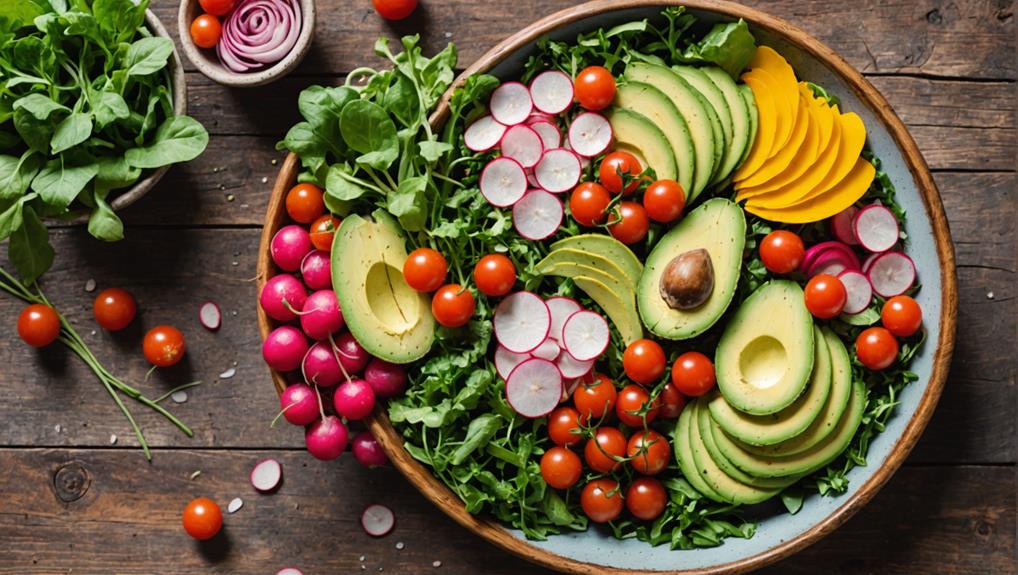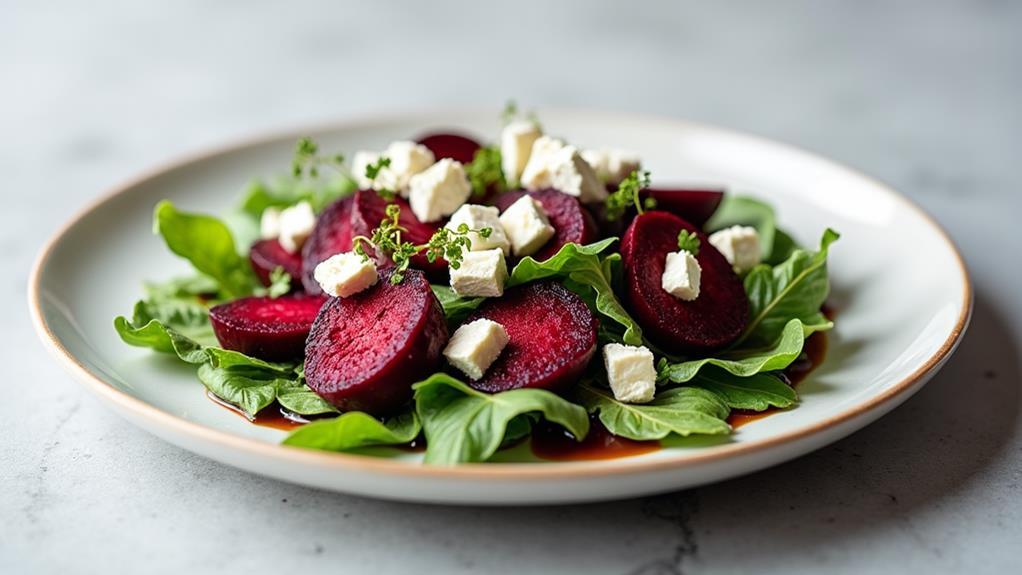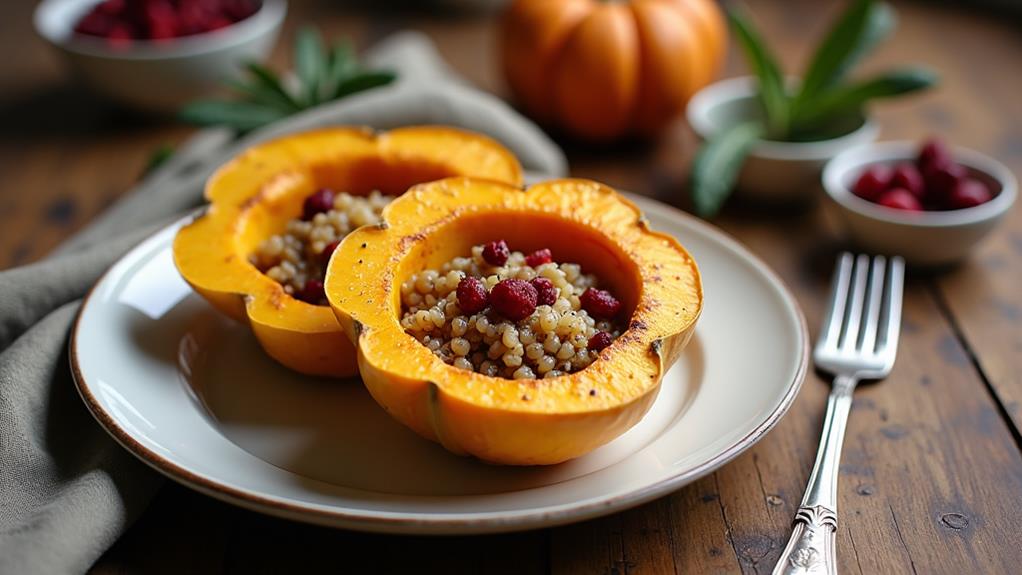To create eye-catching salads, start with a diverse base of fresh, colorful greens. Incorporate vibrant ingredients like bell peppers, carrots, and purple cabbage for visual appeal. Add texture with crunchy nuts, creamy avocado, and crispy vegetables. Arrange ingredients artfully, using techniques like stacking or fanning to create depth and interest. Create focal points with standout ingredients, and use garnishes like edible flowers or herb sprigs for flair. Choose the right vessel, whether it's a bowl for dressed salads or a plate for composed presentations. Layer ingredients strategically, balancing proportions and textures for a harmonious blend. By mastering these techniques, you'll elevate your salads from ordinary to extraordinary.
Curating Fresh Ingredients
When it comes to creating an eye-catching salad, curating fresh ingredients is the foundation of your masterpiece. Start by selecting a diverse array of lettuce varieties to create visual interest and establish a nutritious base. Choose romaine for its crisp texture and nutrient density, red leaf for a touch of sweetness, or butter lettuce for its delicate flavor profile.
Adding roasted beets enhances both flavor and color, as roasting beets enhances their sweetness and tenderness, making them a vibrant addition to your dish.
To elevate your salad's appeal, incorporate leafy greens like arugula or spinach. These additions not only enhance the nutrient content but also introduce beautiful colors and unique flavors.
Don't shy away from vibrant, crunchy toppings such as radicchio and endive, which will add depth to both the visual presentation and texture of your creation.
Always prioritize fresh, seasonal ingredients to ensure optimal flavor and nutritional value. This approach not only supports local producers but also guarantees you're working with the best nature has to offer.
Aim for a kaleidoscope of colors and shapes by mixing various vegetables and fruits. This diversity will significantly boost your salad's visual appeal, making it irresistible to diners.
Vibrant Color Combinations
A salad's visual appeal hinges on its vibrant color combinations. When you're crafting your next masterpiece, think of your salad bowl as an artist's palette. By incorporating a spectrum of hues, including the stunning apples from an autumn harvest salad, you'll not only create a feast for the eyes but also boost the nutritional value of your dish.
Start with a base of vibrant greens like arugula or spinach, then layer in pops of color with red bell peppers, orange carrots, and purple cabbage. These eye-catching ingredients will stimulate appetites and enhance dining enjoyment.
To maximize visual impact, pair contrasting colors for depth and intrigue. Try combining dark leafy greens with bright fruits like strawberries or mangoes. This technique not only elevates the aesthetic but also introduces exciting flavor combinations.
For a refined touch, use tools like mandolins to create uniform cuts, ensuring each colorful component contributes to the overall harmony. Remember, a well-composed salad is a work of art that engages multiple senses.
Textures That Pop
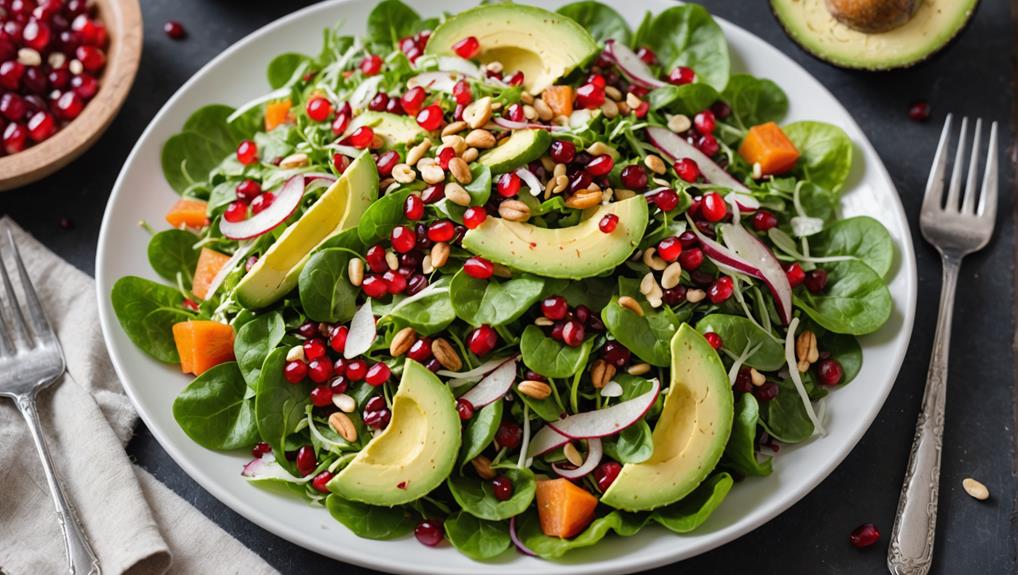
The interplay of textures in a salad can transform it from ordinary to extraordinary. By incorporating a variety of textures that pop, you'll create a sensory experience that's both visually appealing and satisfying to eat.
Consider adding crunchy nuts, creamy avocado, and crispy roasted vegetables, as seen in the nutritious combination of a herbed quinoa salad, to elevate your salad's texture profile. Don't overlook the power of thinly sliced radicchio or endive, which introduce a satisfying crunch that contrasts beautifully with softer leafy greens.
To further enhance your salad's textural diversity, try these innovative techniques:
- Sprinkle seeds like hemp or sunflower for an extra layer of crunch
- Utilize diverse cuts, such as julienned vegetables or shredded greens
- Layer components strategically, cascading shredded greens over hearty toppings
- Incorporate ingredients with varying degrees of firmness and moisture
Artful Arrangement Techniques
Crafting an eye-catching salad presentation goes beyond mixing ingredients; it's about creating a visual masterpiece. To elevate your plating skills, consider these artful arrangement techniques that'll transform your salads into stunning culinary displays.
Start by embracing height. Create tall presentations by stacking leafy greens, drawing the eye upward and adding depth to your dish. For a more expansive approach, experiment with wide arrangements on large plates, showcasing ingredients and encouraging communal dining.
Incorporate patterns like spirals or diagonal lines to guide the viewer's eye across the plate, adding visual interest and structure to your creation.
Don't forget the power of fanning. Thinly slice vegetables like carrots or bell peppers and arrange them in a fan shape to introduce dynamic colors and textures. For a flowing, cascading effect, layer shredded greens to create an inviting, multi-dimensional look.
These techniques not only enhance the visual appeal but also invite diners to explore different flavors and textures within the salad. By mastering these artful arrangements, you'll turn simple salads into gourmet masterpieces that are as pleasing to the eye as they're to the palate.
Creating Focal Points
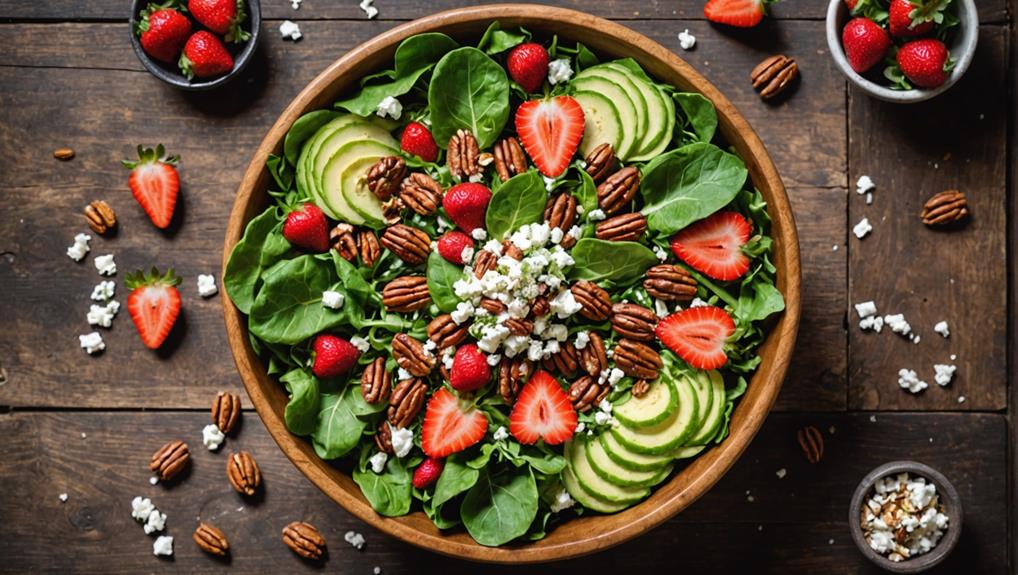
When creating focal points in your salad presentation, consider layering ingredients for maximum visual impact.
You can build height by stacking components or using tall containers, which naturally draw the eye and create interest.
Additionally, strategically place standout ingredients, such as vibrant cherry tomatoes or a beautifully sliced avocado, in central positions to guide your diner's gaze and invite them to explore the dish's flavors.
Layering for Visual Impact
By strategically layering ingredients, you'll transform a simple salad into a visually stunning masterpiece. The art of layering not only adds depth but also creates an enticing visual experience that'll captivate your diners.
To achieve this effect, start with a foundation of shredded greens, then build upward using whole leaves for height and texture. As you construct your salad, focus on incorporating complementary colors to stimulate the appetite and enhance visual appeal.
To create a salad that's as pleasing to the eye as it's to the palate, follow these innovative layering techniques:
- Use clear or glass serving dishes to showcase your colorful layers
- Alternate between finely chopped and whole ingredients for textural contrast
- Incorporate vibrant vegetables like tomatoes, cucumbers, and carrots for pops of color
- Place standout ingredients, such as sliced avocados or roasted vegetables, at the top as focal points
Strategic Ingredient Placement
Strategic ingredient placement takes your layered salad to the next level, transforming it into a visual masterpiece. By carefully positioning key elements, you'll create a dish that's not only delicious but also captivating to the eye.
Start by establishing a focal point in the center of your salad. Vibrant cherry tomatoes or thinly sliced radishes can draw attention and set the stage for the surrounding ingredients.
To enhance the overall appeal, use color contrast to your advantage. Place dark leafy greens like kale or spinach next to brightly colored vegetables such as orange carrots or red bell peppers. This strategic arrangement will make each ingredient pop, creating a visually striking composition.
Don't forget to add dimension by varying the height of your components. Stack crumbled feta cheese or roasted vegetables to create interesting elevations throughout the salad.
Finally, frame your creation with complementary elements along the edges. Edible flowers or citrus slices can guide the viewer's gaze towards the main ingredients, completing your salad's eye-catching presentation.
With these techniques, you'll elevate your salad from ordinary to extraordinary, impressing both yourself and your guests.
Garnishes With Flair
Garnishes can transform a simple salad into a visually stunning masterpiece. When plating your salad, consider incorporating fresh herbs as a final touch. Finely chopped basil or cilantro sprinkled over the top not only adds a burst of color but also infuses the dish with an enticing aroma.
To elevate your plated salad further, explore the world of edible flowers and microgreens. These delicate additions provide both visual interest and unique flavors, instantly transforming your creation into a gourmet experience.
For a truly eye-catching presentation, try these innovative garnishing techniques:
- Drizzle balsamic reduction or flavored oils in artistic patterns across the plate
- Scatter toasted nuts or seeds for a pleasing contrast in texture and color
- Arrange vibrant nasturtiums or pansies strategically on top of the greens
- Use pea shoots or sunflower sprouts as a sophisticated microgreen garnish
Choosing the Right Vessel
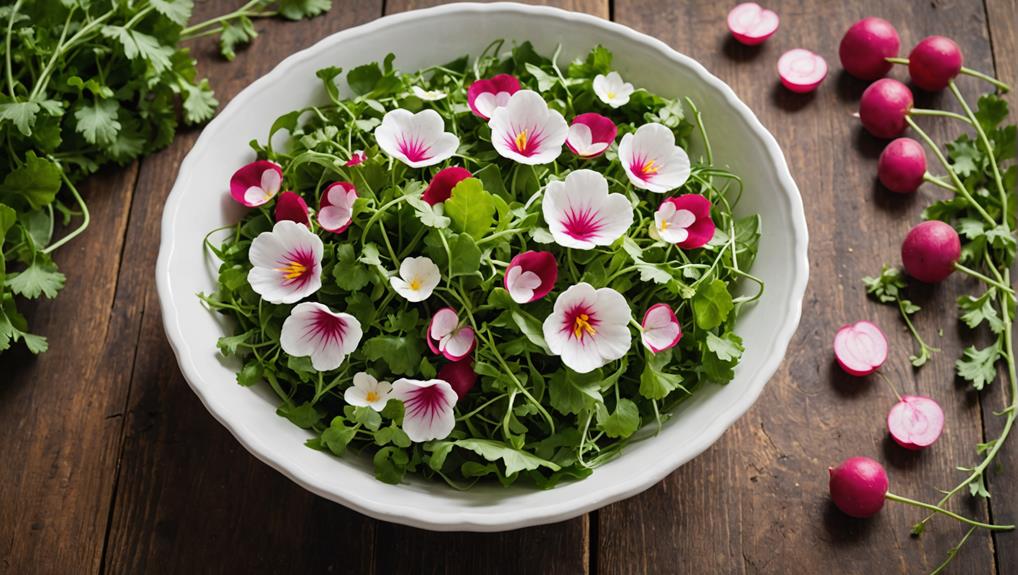
When it comes to presenting your salad, the choice between bowls and plates can significantly impact the overall visual appeal.
You'll want to consider the type of salad you're serving, as well as the setting, to determine whether a deep bowl or a wide, flat plate will best showcase your creation.
Don't be afraid to think outside the box and explore unique serving containers, such as mason jars for layered salads or hollowed-out fruit for tropical-themed dishes, which can add an extra element of creativity to your presentation.
Bowls vs. Plates
The choice between bowls and plates can make or break your salad presentation. Bowl selection is ideal for dressed salads, as it contains ingredients and prevents spillage. This makes bowls perfect for mixed or grain-based salads.
On the other hand, plate choice offers a wider canvas, allowing you to spread out ingredients and create visually stunning layered or composed salads.
When deciding between bowls and plates, consider these innovative presentation techniques:
- Use deep bowls to create height and drama in your salad arrangement.
- Opt for shallow plates to showcase colorful ingredients across a broader surface.
- Choose ceramic or glass vessels to reflect light and add sophistication.
- Select larger bowls for communal salads, encouraging sharing at gatherings.
The material of your serving vessel also plays a crucial role in elevating your salad's appearance. Ceramic and glass options can enhance the overall presentation by reflecting light and adding a touch of elegance.
For a more personalized dining experience, individual plates allow for customized servings, while larger bowls are perfect for family-style meals. By carefully considering these factors, you'll create salads that not only taste great but look impressive too.
Unique Serving Containers
Countless unique serving containers can elevate your salad presentation from ordinary to extraordinary. By thinking outside the traditional bowl, you'll create a visually appealing and memorable dining experience.
Consider using mason jars or colorful bowls to add a fun, playful touch to your salads. Clear glass containers are particularly effective, allowing the vibrant ingredients to shine through and entice your guests.
For a more artistic approach, opt for asymmetrical or sculptural serving ware. These unique pieces will draw attention and spark conversation, making your salad the centerpiece of the meal.
If you're serving a composed salad with distinct components, try using platters with built-in compartments. This approach not only enhances the visual appeal but also maintains the integrity of each ingredient's texture and flavor.
When selecting your serving vessels, consider how they complement the colors and theme of your salad. A cohesive look will elevate the overall dining experience and demonstrate your attention to detail.
Layering for Visual Impact
Layering ingredients in your salad isn't just about aesthetics; it's a game-changer for flavor and texture. By strategically arranging your components, you'll create a visually stunning dish that's as delightful to eat as it's to look at.
Start with a foundation of crisp, leafy greens, then build up your salad with an array of colorful vegetables, proteins, and toppings. This layering technique not only enhances visual appeal but also ensures each forkful offers a unique combination of tastes and textures.
To elevate your salad presentation, try these innovative layering techniques:
- Use transparent bowls to showcase vibrant layers
- Create cascading effects with shredded greens or thinly sliced veggies
- Incorporate whole grains or legumes for added structure and contrast
- Arrange ingredients in distinct layers for a striking visual composition
Don't be afraid to experiment with different combinations and arrangements. By playing with colors, textures, and shapes, you'll transform your salad into a work of art that's sure to impress.
Balancing Proportions

When creating eye-catching salads, you'll want to pay close attention to ingredient ratios and layering techniques.
Start by establishing a solid foundation of leafy greens, then carefully add your toppings in a balanced proportion, ensuring they complement rather than overpower the base.
As you build your salad, consider how each layer contributes to the overall visual impact, strategically placing ingredients to create depth and interest that will make your dish truly stand out.
Ingredient Ratios Matter
Have you ever wondered why some salads look more appealing than others? The secret lies in choosing the right ingredient ratios. When crafting your salad, remember that balance is key.
Start with 2 to 3 cups of leafy greens per serving as your base, then add toppings in proportion. This ensures that flavors and textures complement each other without overwhelming the dish.
To create an eye-catching salad, consider these ratios:
- 2 parts leafy greens to 1 part grains or legumes
- 1-2 tablespoons of dressing per serving
- 1 part protein to 2 parts vegetables
- Equal parts crunchy and creamy toppings for texture variety
Layering for Visual Impact
Now that you've mastered ingredient ratios, let's explore how to arrange those components for maximum visual impact. Layering ingredients in your salad isn't just about aesthetics; it's a strategic approach to creating a balanced flavor profile and ensuring each bite is a harmonious mix of textures and tastes.
Start with a foundation of leafy greens as your base. Next, add protein-rich ingredients like quinoa or edamame. Finally, top it off with vibrant elements such as roasted vegetables or nuts. This layering technique not only creates visual appeal but also builds excitement for the dining experience.
To take your presentation to the next level, consider using varying heights and shapes. Try stacking ingredients in a tall glass for an impressive display that draws the eye. Aim for a balance in proportions, using roughly equal parts leafy greens and toppings. This ensures no single ingredient overwhelms the others while maintaining visual harmony.
Remember to incorporate diverse textures through strategic layering. Combine crunchy nuts, creamy avocado, and tender greens to enhance both the aesthetic and sensory experience of your salad.
Personal Touches and Creativity
A dash of creativity can transform an ordinary salad into a captivating culinary masterpiece. By incorporating personal touches and creative plating techniques, you'll elevate your salad from a simple side dish to a stunning centerpiece.
Experiment with unique ingredients like edible flowers or vibrant fruits to add visual interest and excitement to your creation. Don't be afraid to mix textures, combining crunchy nuts with creamy avocado for a dynamic eating experience that engages multiple senses.
To make your salad truly eye-catching, try these innovative presentation ideas:
- Fan out thinly sliced vegetables in a circular pattern
- Arrange ingredients in colorful stripes or geometric shapes
- Use a ring mold to create perfectly stacked layers
- Serve individual portions in unexpected containers like mason jars or hollowed-out fruits
Personalize your salad further by crafting homemade dressings or adding unique toppings that reflect your taste preferences. These signature touches will make your creation stand out and showcase your culinary creativity.
Frequently Asked Questions
How Do You Present Your Salad More Attractive?
You'll make your salad pop by stacking greens high, adding colorful toppings, and arranging ingredients in eye-catching patterns. Don't forget vibrant salad garnishes and artistic dressing drizzles. Serve in unique dishes to showcase your innovative creation.
How Do You Dress Greens?
You'll revolutionize your salad game by experimenting with innovative dressings and flavor combinations. Drizzle your vinaigrette just before serving, ensuring even coating. Don't be afraid to mix unexpected ingredients for a unique twist on classic salad dressings.
What Is the Proper Way to Dress a Salad?
You'll want to mix your salad dressing separately, ensuring flavor balance. Gradually add it to your greens, tossing gently. Don't overdo it—you're aiming for a light coat that enhances, not drowns, your innovative salad creation.
How to Present a Salad Nicely?
Stack your greens high in unique salad bowls. Add colorful toppings in eye-catching patterns. Drizzle dressing artfully. Use contrasting textures and vibrant ingredients to create visual interest. Experiment with unexpected elements to elevate your salad's presentation.
Final Thoughts
You've now got a palette of techniques to transform your salads from drab to fab. By focusing on fresh ingredients, vibrant colors, and diverse textures, you'll create eye-catching masterpieces that'll make mouths water before the first bite. Remember, presentation is key—artfully arrange your components, create focal points, and choose the right vessel to showcase your creation. With these tools in your culinary arsenal, you'll be dressing up your leafy greens like a pro, turning every salad into a feast for the eyes.

